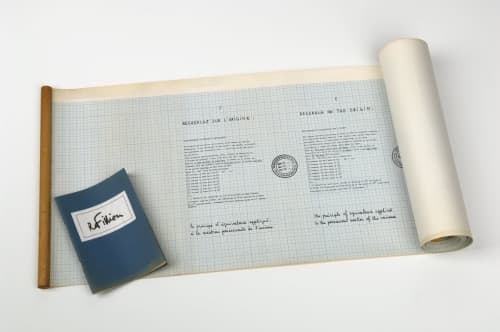On September 19th, ADN Galeria inaugurates “Recherche sur l'origine 1974”, a Robert Filliou exhibition.
It’s been 50 years since Robert Filliou produced the piece Recherche sur l'origine between Berlin and Düsseldorf, which, in conjunction with Principe d’équivalence and Le Poïpoïdrome, is the artist's most emblematic triad. It is a monumental textile work of almost 84 meters long by 2.71 meters high, covered with inscriptions, symbols and drawings from the sciences, religions and myths where he claims a parallelism between universal creation and human creation processes.
Filliou produced an edition of Recherche sur l'origine of 400 copies that are not just a miniaturization of the original model. The edition includes a booklet that helps us to understand the intentionality of the piece and the decisive stages of cosmogonic creation - Big Bang, expansion and condensation, separation between matter and antimatter, the radioactive era, the distribution of stars, the appearance of white dwarfs, the birth of the sun, of the earth, of life on earth, of consciousness, etc. -thus operating a rapprochement between astrophysics and Eastern mystical philosophies and following the Tao of Physics of Fritjof Capra. The exhibition shows one of these editions.
Thus, Robert Filliou leads us to a repertoire of experiences, competencies and knowledge that are within everyone's reach, and for this very reason denote a political positioning of socialist and anarchist tradition. For example, the marvelous idea of the Principle of Equivalence between the well done, the badly done and the not done, is revealed to us as antagonistic to the false emancipatory paradigm of meritocracy, distinction and strong authorship proper to modernity - read indistinctly Western capitalism-.
This principle of inclusivity and leveling, as well as his Principles of Poetic Economy, all drink from that period spirit which, from the end of the 1950s, manifests a holistic intellectual drift articulated between Buddhism and experimental sciences, especially in the USA, where Filliou had been trained in political economy. All this in tune with that old avantgarde claim of dilution between art and life. It is in that same constellation, agglutinated thanks to the gravitational force of Fluxus, where he met George Brecht, another of the emblematic artists of the time, a great friend and collaborator in many projects.
Instead of art, art system or aesthetic and conceptual formalizations, Filliou invites us to the “Permanent Creation”, to the “Genial Republic” or to multiple Principles and Investigations to refer to practices and ways of thinking that are not teleological, without attribution of finality or concreteness, beyond free choice in doing and inactivity. This is something that especially challenges us today, where there are rankings for everything: sports world records, financial performance of all kinds of stock market indexes, lists of influence in the art, literary and culinary world, annual results per artist in primary and secondary markets, kpis for management control panels both in the cultural industries and in the rest of the sectors, audiences in networks, shares and media impact values and an endless number of econometrics in search of yields.
To counteract the last, we hope to contribute to generate interest among our audience for an artist whose imprint, given the current logic of valuation between winners and losers, could not seem to us more relevant and inspiring to question the hegemony of the economy of attention. To this end, we accompany this Research on Origin with several works, both multiple and single pieces from ADN Collection, aware that it is neither the best framework it deserves, nor the most articulate selection of works by this “genius without talent”. In addition to two original collage drawings made on cardboard boxes, With Love from Cromagnon and Drunken Horse, both from 1972, and the brick-book La Nostalgie du Souvenir from 1980, we highlight 7 Childlike Uses of Warlike Material, a work made in Düsseldorf together with Hartmut Kaminski, where he transforms with playful imagination the idiosyncrasy of war machinery by placing it in unsuspected places: “I can put the submarine in the mountains, the missile on the moon, the uniforms among the stars”.
French poet and artist involved in the Fluxus group. Filliou was born in 1926 in the town of Sauve, in the south of France. At the age of 17 he joined the French resistance and later moved to the United States. There he graduated in Political Economy at the University of California, and during the following years he worked for the UN until the early 1960s when he came into contact with a series of poets and artists who determined the beginning of his career as a 'permanent creator'. In 1960, he designed his first visual work, Le Collage de l'immortelle mort du monde, and initiated the festival "The Birthday of Art" which was celebrated publicly for the first time in 1973 in Aachen. That same year he performed with Jannis Kounellis, Wolf Vostell, Allan Kaprow and Mario Merz in Berlin, at the ADA - Aktionen der Avantgarde. Collaboration with other artists would mark her career, as was the case with her relationship with Georges Brecht, with whom he would create the atelierboutique “La Cédille qui sourit” in 1965. His work from the 1960s, when he had an intermittent relationship with the Fluxus movement, could be described as poetic, among other things because he often used his favourite materials (paper, cardboard, wood, canvas) as a support for words.
September 19, 2024


